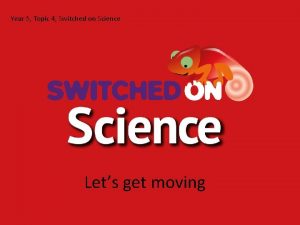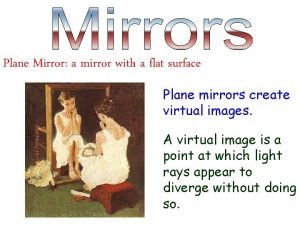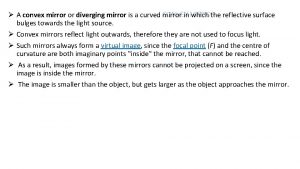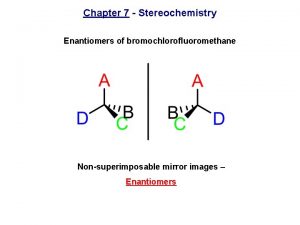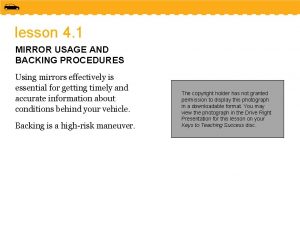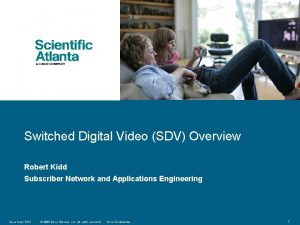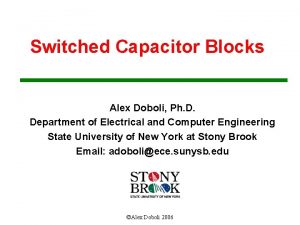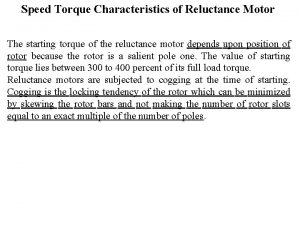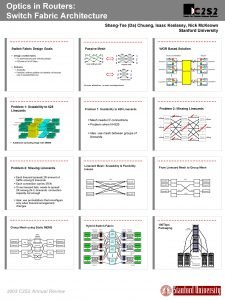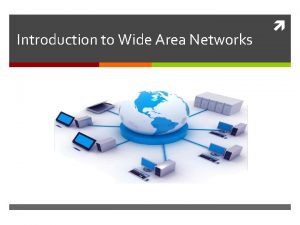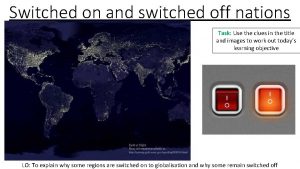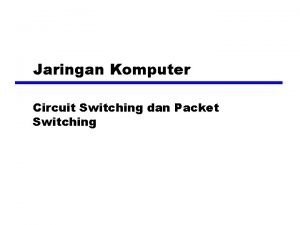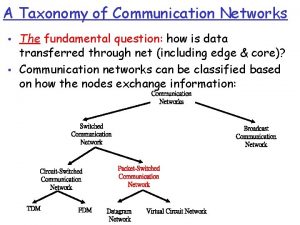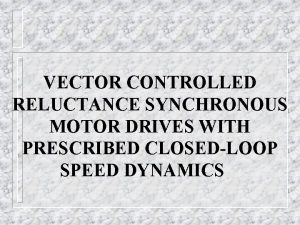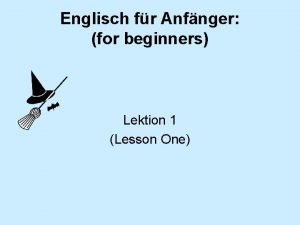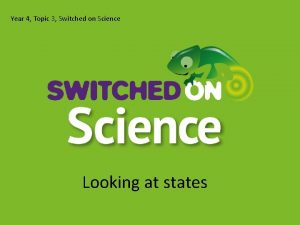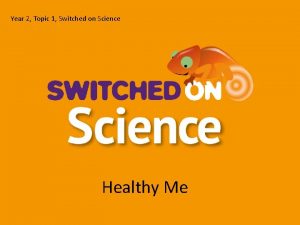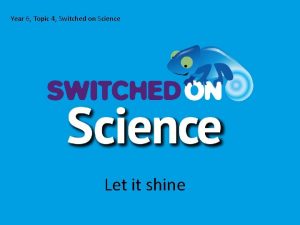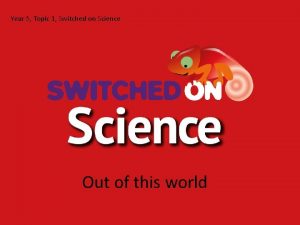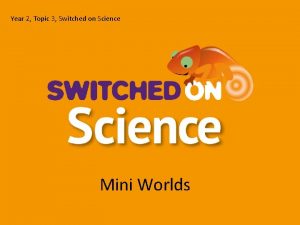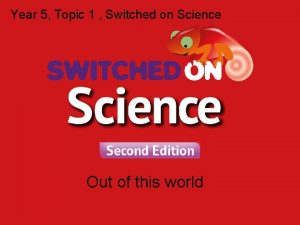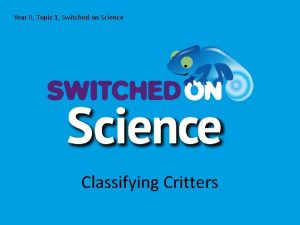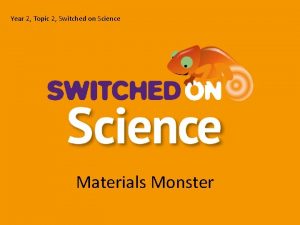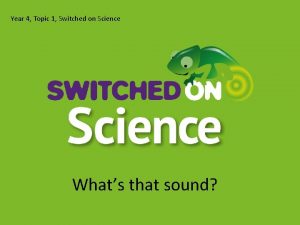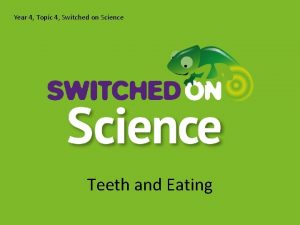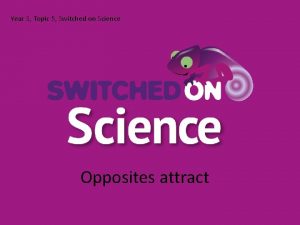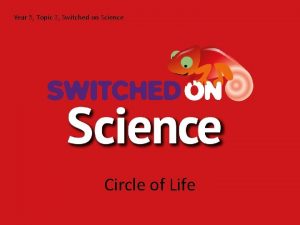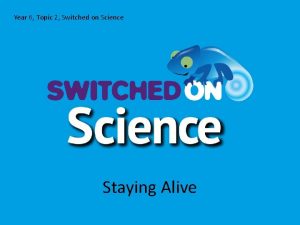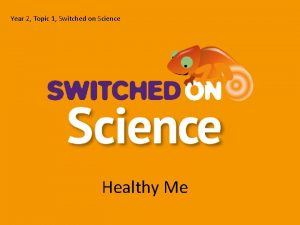Year 3 Topic 3 Switched on Science Mirror


































- Slides: 34

Year 3, Topic 3, Switched on Science Mirror

Key Vocabulary • • Mirror Light source Dull Shiny Observation Description Explanation Shadow • • Transparent Translucent Opaque Coating Light ray Kaleidoscope Blocked Telescope

In this topic you will: • • say what happens when light is reflected make sense of some observations describe how shadows are formed design and carry out a fair test find out how mirrors have been made make a simple mirror list some uses of mirrors.

Unit 1: Time to reflect Can you: • • name sources of light? sort materials into good and bad reflectors? say what a reflection in a mirror looks like? build a mirror maze?

Let’s think like scientists • • • What is a light source? What are the most common sources of light? Do all materials reflect light? What is an image? What materials produce clear images? What is a fair test?

Right or wrong? Are these ideas right or wrong? Only mirrors make reflections. All reflections in mirrors look lifelike. Images are actually on the surface of mirrors.

Answers • No. You can see your reflection in many shiny materials. • No. Some mirrors make your reflection look bigger or smaller. • No. There is no image ON the mirror. The mirror reflects the light into your eyes.

Find the light source! • Draw a plan of your school. • Tour the school in teams. • Add the different sources of light you find on your plan.

Did you know • When the Biami people of New Guinea were first shown a mirror in the 1970 s they were terrified! • Why do you think that was?

Quick Teaser Some shops have security mirrors. Why do you think that is?

Shiny or dull? Test some materials to find out if they are shiny or dull. Put your results in a table like this one. Surface Mirror Polished metal sheet Sheet of Perspex Sheet of paper Piece of polished wood Shiny painted surface Dull or Shiny Is light from a torch reflected? Can I see my face in it?

Reflections • Shiny materials such as mirrors, polished metals and still water reflect light very well.

What can you see? • Collect some different mirrors. Describe what you see when you look in them. Put your answers in a table like this one. Type of Mirror What does the reflection look like?

Why do you see a reflection? • When light bounces (is reflected) off a shiny object it changes direction and enters your eyes. • This is how you see things. • You can imagine there are rays of light that travel in straight lines.

Be creative: Make a mirror maze Use some mirrors and a torch to make light travel around corners. Try to use more than one mirror.

Unit 2: Shadow shapes Can you: • Draw a diagram that shows how shadows are formed? • Sort materials into those which are transparent, translucent and opaque? • Investigate how to make shadows bigger or smaller?

Let’s think like scientists • What is the difference between a shadow and a reflection? • How do you make a shadow? • What materials form the best shadows? • Are shadows formed in daytime? • How do you change the size of shadows? • Can you touch a shadow?

Right or wrong? Are these ideas right or wrong? Shadows are not related to the object that causes them. Shadows are special reflections of objects. Shadows are formed by dark light.

Answers • No. Every shadow must be cast by an object. • No. They are caused when an object blocks light. • No. No light is dark!

Translucent materials and shadows • Translucent materials block most of the light. • Tracing paper and bubble wrap are good examples. • They form semi dark shadows.

Transparent materials and shadows • Transparent materials let nearly all the light through. • Smooth glass and clear plastic film are good examples. • These make very faint shadows or none at all.

Sorting materials Sort the following materials into those which are opaque, translucent and transparent.

Predicting the darkness of shadows • Collect a range of materials. Predict how dark the shadows they make will be. Test them to see if your predication was correct. Name of material How dark will its shadow be Was my prediction correct?

Make a shadowgraph Make some shadow puppets out of different materials. Use them with a torch and a screen made out of white card to see how dark the shadows they make are. Make a puppet play for another class, telling them all about your shadows.

Doing a fair test Jack used his teddy to test how he could change the size of Teddy’s shadow. What apparatus did he use? What did he keep the same in his test? What did he change in his test? What kind of material is Teddy made out of? How do you know? What did Jack think made the shadow bigger?

Unit 3: Magic mirrors Can you: • Make a timeline which shows how mirrors have been made in history? • Name at least ten different uses of mirrors? • Decide on the best way to show the results of an investigation?

Let’s think like scientists Who made the first mirrors? Why were they made? How do you make a mirror? Is there more than one way to make a mirror? What is the biggest mirror in the world? What can mirrors be used for?

Right or wrong? Are these ideas right or wrong? There is only one kind of mirror. Mirrors were first made in China

Answers • No. Mirrors can also be curved. Some curve outwards and some curve inwards. • No. The first mirrors were made in Anatolia, Turkey, eight thousand years ago.

Make your own mirror You will need: Aluminium foil; Stiff card; Glue; Clear plastic; and Clingfilm. How do you think you would make it? How could you change the design? What do you have to do to make a really good mirror? How might you change the design to make the reflections look different?

What is the biggest mirror in the world? This is the Salar de Uyuni, the largest salt flatland in the world at 4, 086 square miles (10, 582 kilometers). Every year, this amazing wonderland in southwest Bolivia covers with a thin layer of water. When that happens, it turns into the largest mirror on the planet.

Early mirrors • The earliest mirrors were made form polished metals such as copper. • They were very expensive. • People used them to look at their reflection.

Modern mirrors? • These are usually made by coating glass with a thin film of a metal such as silver or gold. • They are mass produced.

The palace of Versailles, France • The French king, Louis XVI, had the hall of mirrors built at great expense in 1678. • It was made possible by new ways of producing glass invented in Venice, Italy.
 Packet switched vs circuit switched
Packet switched vs circuit switched Switched on science
Switched on science Switched on science
Switched on science Any mirror with a flat surface
Any mirror with a flat surface Convex mirror is a diverging mirror
Convex mirror is a diverging mirror Nonsuperimposable
Nonsuperimposable Mirror mirror commonwealth fund
Mirror mirror commonwealth fund The rearview mirror should be checked
The rearview mirror should be checked It is my favourite subject
It is my favourite subject What is a clincher sentence
What is a clincher sentence Research problem example for students
Research problem example for students Sdv video
Sdv video Switched cap building block
Switched cap building block Torque speed characteristics of switched reluctance motor
Torque speed characteristics of switched reluctance motor Switched fabric architecture
Switched fabric architecture Wan switching
Wan switching Switched backbone
Switched backbone Why is north korea switched off from globalisation
Why is north korea switched off from globalisation Switched ethernet vs shared ethernet
Switched ethernet vs shared ethernet Charge pump converter
Charge pump converter Public switched telephone network diagram
Public switched telephone network diagram Circuit switched networks
Circuit switched networks Transmission plan in telephone network
Transmission plan in telephone network Pstn hierarchy
Pstn hierarchy Pstn
Pstn Slotted optical switches
Slotted optical switches Drei hexen schauen sich drei swatch uhren an
Drei hexen schauen sich drei swatch uhren an Cisco borderless switched network design
Cisco borderless switched network design Taxonomy communication
Taxonomy communication Switched reluctance motor
Switched reluctance motor Comparison of virtual circuit and datagram networks
Comparison of virtual circuit and datagram networks Public switched telephone network notes
Public switched telephone network notes Three swiss witches
Three swiss witches Virtual circuit switching example
Virtual circuit switching example Introduction to switched networks
Introduction to switched networks

